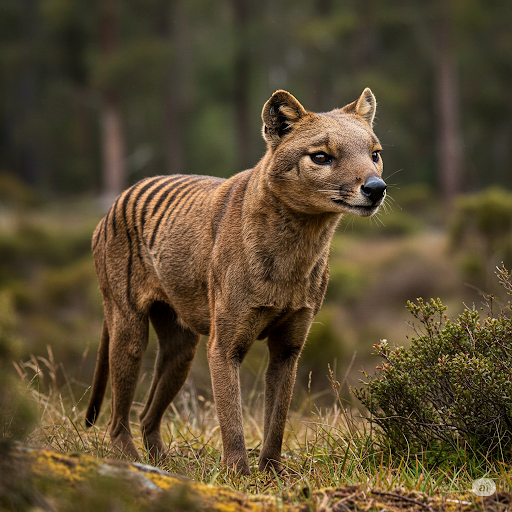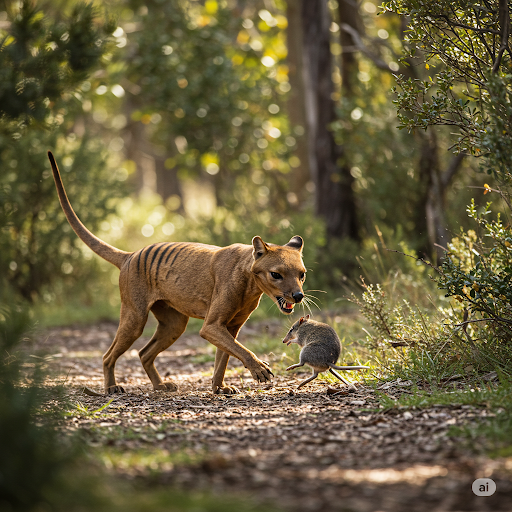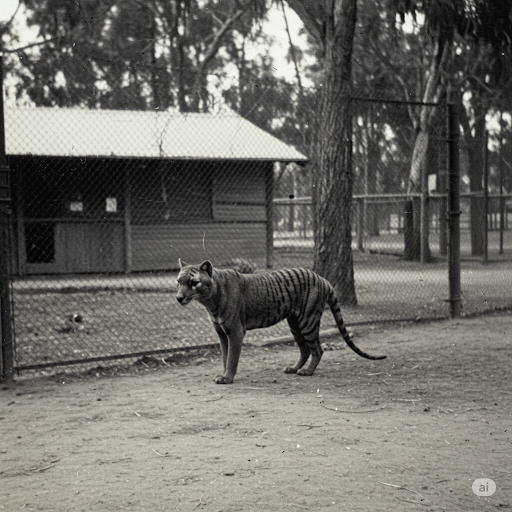The Tasmanian Tiger (Thylacinus cynocephalus) is one of the most well-known carnivorous marsupials that became extinct in the modern era. Native to Australia’s fauna, this species survived for a long time on the island of Tasmania. Due to factors such as intensive hunting following European colonization, habitat loss, and competition, it became extinct in the early 20th century.
Morphology and Evolutionary Characteristics
Physical Structure
The Tasmanian tiger was a medium-sized carnivorous marsupial, with a body length ranging from 100 to 130 cm and a tail length between 50 and 65 cm. Its weight typically ranged from 15 to 30 kg, with males being slightly larger than females. It was nicknamed “tiger” because of the distinctive dark stripes on its back. Its short and coarse fur was generally yellowish-brown in tone. The skull structure, jaw muscles, and dental arrangement were adapted to carnivorous feeding.

Tasmanian Tiger (Generated by Artificial Intelligence)
Evolutionary Position and Convergent Evolution
Thylacinus cynocephalus is the last known member of the family Thylacinidae. Genetic analyses indicate that this species diverged from placental mammals approximately 160 million years ago. Despite this evolutionary distance, it shows remarkable morphological similarities to placental carnivores such as wolves and dogs, representing a striking example of convergent evolution. This resemblance can be explained by different species occupying similar ecological niches and developing comparable adaptations under analogous environmental pressures.
Ecology and Behavior
Habitat and Distribution
Historically, the Tasmanian tiger was widely distributed across mainland Australia and the island of Tasmania. However, the mainland population became extinct around 3,000 years ago, while the Tasmanian population persisted until the early 20th century. The species inhabited a variety of environments, including forests, shrublands, and open plains.
Feeding and Hunting Behavior
As a carnivorous species, the Tasmanian tiger fed on small to medium-sized mammals. Its skull and dental structure evolved to catch and tear apart prey. Some studies suggest that this species employed an ambush hunting strategy, capturing prey by waiting rather than actively chasing it.

Tasmanian Tiger and Small Prey (Generated by Artificial Intelligence)
Reproduction and Development
As a marsupial mammal, the Tasmanian tiger carried its young in a pouch after birth. The offspring spent several months developing within the pouch before becoming more independent. Detailed information about its reproductive behaviors remains limited.
Extinction and De-Extinction Efforts
Extinction Process
The extinction of the Tasmanian tiger resulted from a combination of factors. Following European colonization, intense hunting campaigns were launched due to the belief that the species attacked sheep. Between 1888 and 1909, the Tasmanian government offered bounties for each adult individual killed. This practice caused a rapid decline in the population. Additionally, habitat loss, pressure from competing species such as dingos, and reduced genetic diversity accelerated the extinction process. The last confirmed individual died in 1936 at the Beaumaris Zoo in Hobart.

The Last Surviving Tasmanian Tiger (Generated by Artificial Intelligence)
De-Extinction Efforts
In recent years, studies on the genetic material of the Tasmanian tiger have brought the possibility of species revival into consideration. Scientists have successfully sequenced the genome of this species and made advances in stem cell technologies.


